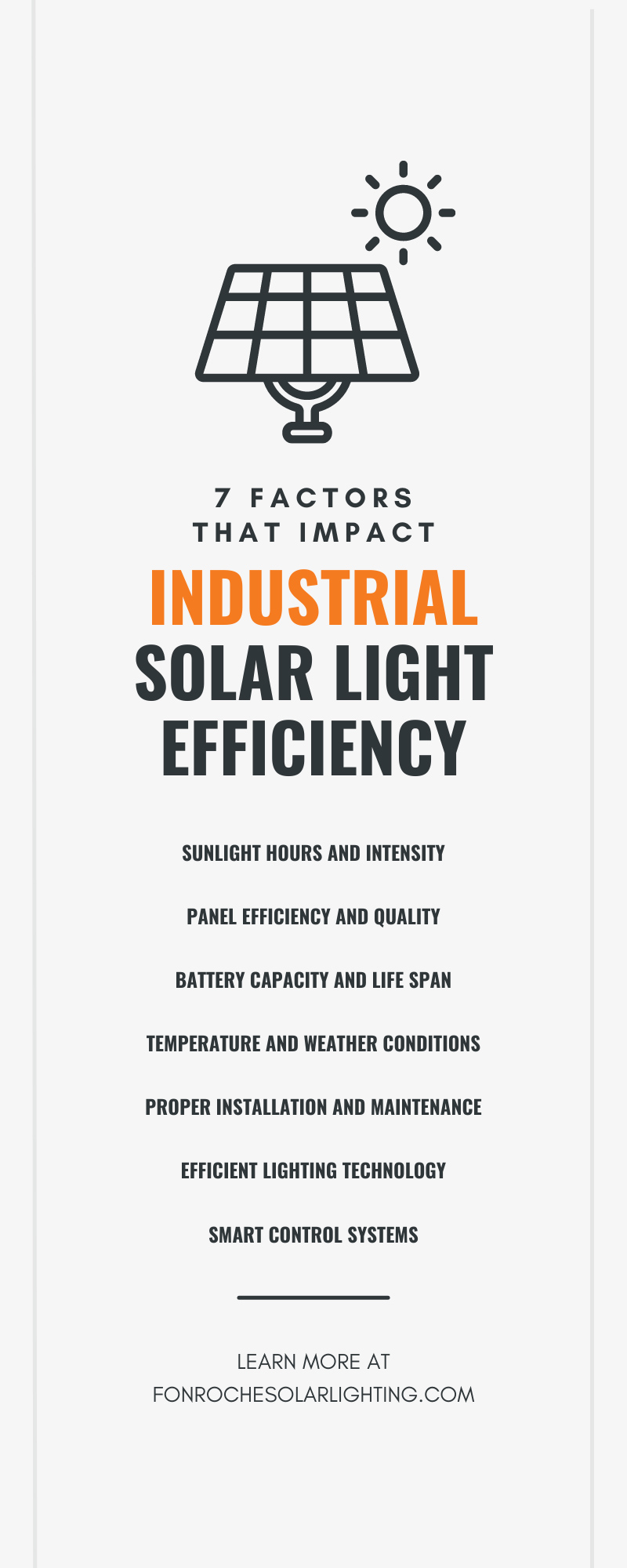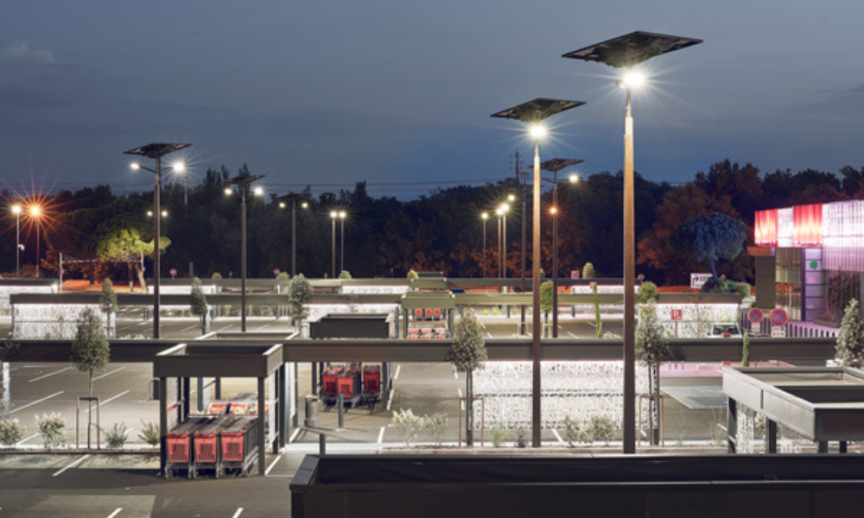As the demand for renewable energy sources continues to grow, industrial solar lights have become a popular and eco-friendly option for businesses and organizations operating in diverse sectors. These solar-powered lights offer numerous benefits, such as lower operating costs, reduced carbon footprint, and minimal maintenance requirements. However, not all industrial solar lights are equal, and there are a variety of factors that can affect their efficiency. In this blog post, we’ll explore seven critical factors that impact industrial solar light efficiency. We’ll offer valuable insights and actionable tips to help you optimize the performance of these lights and reap their full potential benefits. Let’s dive in and discover how you can improve your industrial solar lighting system’s efficiency and get better value for your investment.
Sunlight Hours and Intensity
The amount of sunlight a location receives is one of the most important factors when it comes to industrial solar light efficiency and capacity. This includes direct sunlight and indirect diffuse radiation from clouds and other sources. The more hours of sunlight there are and the more intense the sunlight is, the more efficient industrial solar lights will be.
The angle of the sun is just as important. For example, in locations that experience seasonal changes, such as the northern hemisphere, the angle of the sun will change drastically throughout the year. During the long days of summer (and short nights of lighting demand), the solar lighting systems may collect all the energy they need before midday. In the shorter days of winter when the sun is low in the sky, there is less energy, and your system will need more panel surface to collect enough energy. This means you should select the solar components for the lighting based on your specific location and the worst-case winter conditions.
Panel Efficiency and Quality
The quality of solar panels plays a significant role in the overall performance of industrial solar lights. When selecting a solar panel, consider its efficiency rate and power output. High-efficiency panels are more expensive, but they can produce more electricity in less time. They also require fewer solar cells to generate the same amount of power as lower-efficiency models.
In addition, you should evaluate the durability of the solar panel. Good-quality panels made from durable materials can last for many years without requiring significant maintenance or repairs. Poor-quality panels may suffer from significant wear and tear over time, reducing their efficiency and ultimately leading to higher energy bills. Look for IEC Certification and performance warranties of 25 to 30 years.
Finally, you should consider the size of the solar panel you select. Larger panels can collect more sunlight and generate more power. Smaller panels that are typically provided with all-in-one systems are usually insufficient for reliable all-night commercial service.
By carefully assessing your solar panel options, you can select a system that’s both efficient and cost-effective over the long term.
Battery Capacity and Life Span
The battery capacity of your industrial solar lights determines how much energy they can store and, in turn, how long they can illuminate a given area. Investing in a high-capacity battery with a long life span ensures consistent service and reduces maintenance and replacement costs. New battery technologies like nickel-metal halide and lithium iron phosphate allow you to access more of your battery’s capacity without shortening the life of the battery. To prolong battery life, consider options such as energy-saving modes, variable lighting schedules, and smart energy management systems.
Temperature and Weather Conditions
To achieve optimal efficiency from your industrial solar lights, select solar panels and batteries made to withstand extreme temperatures and weather conditions. High temperatures can reduce the efficiency of some solar panels.
Temperature impacts battery life too. High temperatures can shorten a lead-acid battery’s life by half or more, and freezing temperatures can cause damage to lithium-based batteries. Nickel-metal halide batteries formulated for both temperature extremes are recommended.
Choose solar panels with temperature-tolerant properties and batteries specifically designed for extreme climates. This will ensure your industrial solar lights work optimally, regardless of the weather or temperatures they face.
Proper Installation and Maintenance
Proper installation and maintenance of industrial solar lights are key to maximizing efficiency. Ensure the installers place the lights at the correct height, angle, and distance for the intended application. Panels that do not face south as intended will be much less effective than those with the correct orientation. Complete any testing indicated by the manufacturer. Additionally, replace worn-out or damaged components in a timely manner to maximize the efficiency of your industrial solar lighting system. With proper installation and maintenance, solar lights can provide reliable illumination for years to come.
Efficient Lighting Technology
The choice of lighting technology significantly affects power consumption and efficiency. LED lights are a popular option for industrial solar lighting as they consume less energy and provide more light output than traditional lighting options like CFLs or halogen bulbs. Additionally, LED lights have a longer life span, reducing maintenance and replacement costs over time.
Smart Control Systems
Integrating smart control systems can improve the efficiency of industrial solar lights. Wireless or embedded controls can adjust the lighting output based on local conditions and time of day. By using these advanced features, you can reduce energy consumption and get the most out of your solar lighting system, ensuring a cost-effective and sustainable solution.
Understanding the numerous factors that impact industrial solar light efficiency is crucial for businesses and organizations looking to implement or upgrade their solar lighting systems. By focusing on these seven key components, you can optimize your solar lighting’s performance, reduce energy costs, and contribute to a more sustainable future. Keep in mind the importance of choosing the right solar panels and selecting appropriate batteries. You should also remember to maximize the panels’ exposure to sunlight, optimize lamp efficiency, factor in weather conditions, and ensure proper installation. Once the panels are installed, conduct regular maintenance checks to keep them in good shape and functioning efficiently.
For a comprehensive and reliable solution to your industrial solar lighting needs, look no further than Fonroche Lighting America. We offer an extensive range of commercial solar outdoor lighting solutions tailored to meet the unique requirements of businesses and organizations across diverse sectors. We design our advanced lighting systems with superior technology, quality components, and rigorous engineering standards to deliver maximum efficiency and cost savings. With our expert guidance and support, you can rest assured that your industrial solar lighting system will provide high performance and long-term sustainability. Contact us today to learn how we can help bring your vision of an eco-friendly, efficient, and cost-effective industrial solar lighting solution to life.


